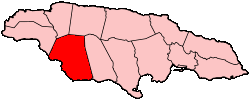
Population: 148,900 (as of 1999)
Capital: Black River
Major Towns: Santa Cruz, Malvern, Junction, Balaclava

St. Elizabeth is situated in the southwestern region of Jamaica and spans approximately 1,212.4 square kilometers (468.1 square miles). The parish is defined by three distinct mountain ranges: the Nassau Mountains to the northeast, the dramatic Santa Cruz Mountains—with a 1,600‑foot drop at Lovers’ Leap—and the Lacovia Mountains to the west.
The lifeblood of the parish is the Black River, Jamaica’s longest river, which meanders for 53.4 kilometers (33 miles) and is navigable over a 40‑kilometer (25‑mile) stretch. Originating near Coleyville in Manchester, the river flows through underground passages before emerging near Balaclava and finally reaching the sea at Black River.
St. Elizabeth is also home to 44 caves, including the famous Mexico Cave—recognized as the island’s longest—as well as notable sites like Yardley Chase, Wallingford, and Peru Caves. In addition, extensive natural conservation areas protect vital ecosystems, from the Lower Black River Morass to local wetland and wildlife sanctuaries.
The landscape of St. Elizabeth features a mix of dry grasslands, marshes, swamps, forests, and scrub woodlands. Agriculture plays a central role in the local economy. Historically known for sugar cane cultivation and extensive pastures, the parish now supports a range of crops—from bananas and pineapples to tomatoes and onions—while still hosting one of Jamaica’s most renowned sugar factories at the Appleton Estate.
Named in honor of the wife of Sir Thomas Modyford, Jamaica’s first English Governor, St. Elizabeth once encompassed most of the island’s southwest. Over the centuries, the area has witnessed Taino/Arawak settlements, Spanish ranching, and the rise of sugar cane plantations following the English conquest in 1655. Innovations such as the introduction of electric power in Black River (1893) and the arrival of Jamaica’s first motor car (1903) mark its progressive legacy.
The parish’s multicultural heritage is enriched by descendants of Miskito Indians, Loyalists, Scots, and Germans. Despite challenges like the closure of Black River port in 1968, the discovery of bauxite rejuvenated the local economy, paving the way for community-based tourism initiatives.
Prestigious institutions such as Munro College for boys and Hampton School for girls—both established in the mid-19th century—stand as testaments to the parish’s long-standing commitment to education. Numerous secondary schools built in recent decades continue to serve the community.
St. Elizabeth remains a dynamic blend of history and modernity, balancing its rich cultural legacy with advancements in agriculture, industry, and sustainable tourism.